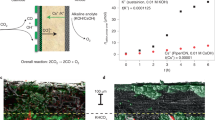Abstract
In a previous paper an electrochemical method for the removal of dissolved oxygen from water was described. In that work the oxygen-rich water was passed through a three-dimensional cathode and the dissolved oxygen was reduced on the cathode surface to water. In the present study electrochemical oxygen removal and, especially, the scale-up of the deoxygenation cell were investigated. The volume of the three-dimensional cathode was enlarged and suitable cathode materials and membranes were tested. The maximum flow rate and the optimum cell voltage were determined. Finally, two cathodes were connected in parallel flow. A flow rate ten times higher than that of the former laboratory-scale cell was achieved. Over 99.95% of the dissolved oxygen was removed. No significant amount of by-products, hydrogen or hydrogen peroxide, was observed.
Similar content being viewed by others
Abbreviations
- A :
-
area of the membrane (m2)
- D :
-
hydrodynamic permeability (g s−1 m−2 bar−1)
- F :
-
Faraday number (96 500 A s mol−1)
- I :
-
current (A)
- I meas :
-
measured current (A)
- I theor :
-
theoretical current (A)
- M i :
-
molecular mass of species i (g mol−1)
- \(\dot m\) :
-
flow rate (g[water] s−1)
- m de :
-
mass of water decomposed on the anode (g) meomass of water transported through the membrane by the electroosmosis (g)
- m ev :
-
mass of water evaporated with the gaseous oxygen (g)
- m p :
-
mass of water transported through the membrane due to the pressure (g)
- m tot :
-
total mass change of the anolyte (g)
- N w :
-
water transference number (2.2)
- p :
-
pressure of the gas bubble (pressure of the air, 101 300 Pa)
- pH2O:
-
water vapour pressure at room temperature (3000 Pa)
- ΔP :
-
pressure difference between catholyte and anolyte (bar)
- [O2]:
-
mass fraction of dissolved oxygen (g[O2] g[water]−1)
- t :
-
time (s)
- z i :
-
number of electrons needed per species i
References
K. Vuorilehto, A. Tamminen and S. Yläsaari, J. Appl. Electrochem., 25 (1995) 973.
A. Bjareklint, L. Carlsson and B. Sandegren, in ‘Electrochemical Cell Design’ (edited by R.E. White eds), Plenum Publishing Corporation, New York (1984), pp. 197–205.
K. Vuorilehto, Thesis, Helsinki University of Technology (1993).
D. Genders, in ‘Electrosynthesis from Laboratory, to Pilot, to Production’ (edited by D. Genders and D. Pletcher eds), The Electrosynthesis Company Inc., New York (1990), p. 73.
M. Demarty, A. Maurel and È. Selegny, J. Chim. Phys., Phys. Chim. Biol. 71 (1974) 811.
N. de Zoubov, C. Vanleugenhaghe and M. Pourbaix, Copper, in ‘Atlas of Electrochemical Equilibria in Aqueous Solutions’, (edited by M. Pourbaix eds), NACE, Houston (1974), pp. 384–392.
Author information
Authors and Affiliations
Rights and permissions
About this article
Cite this article
Tamminen, A., Vuorilehto, K. & Yläsaari, S. Scale-up of an electrochemical cell for oxygen removal from water. J Appl Electrochem 26, 113–117 (1996). https://doi.org/10.1007/BF00248196
Received:
Revised:
Issue Date:
DOI: https://doi.org/10.1007/BF00248196




